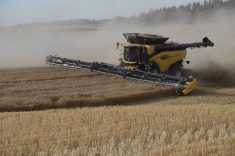Pork producers have a reason to be optimistic as their feed costs drop and demand from the United States strengthens
Glacier FarmMedia – A decline in feed costs and lower hog supplies should create optimism for hog producers, says Farm Credit Canada.
Feed costs as a percentage of revenue are now closer to the historic norm, says FCC senior economist Justin Shepherd. The most recent 2024 data shows feed costs average 63 per cent of revenues in Western Canada and 65 per cent in the East.
Shepherd credits lower commodity prices for corn, soybean meal and distillers grains, among others, for easing feed cost challenges.
Read Also

Huge Black Sea flax crop to provide stiff competition
Russia and Kazakhstan harvested huge flax crops and will be providing stiff competition in China and the EU.
FCC published a recent report noting “the time has come for those in Canada’s hog/pork supply chain to breathe a little easier and take note of some good news.”
At their highest in the post-COVID era, feed costs represented over two-thirds of the cost of production for the average Canadian hog producer, according to FCC data. At their highest, they also equalled 76 per cent in Western Canada and over 80 per cent in Eastern Canada of pork producers’ average revenue.
Confirmation of lower feed costs, echoing a projection FCC made in its annual 2024 outlook in January, should come as welcome news for many.

“The toll that high feed costs exact from hog operations is hard to overstate,” FCC economics editor Martha Roberts wrote, adding the agency’s comparison of feed costs to revenue from 2023 “highlights the near impossibility of breaking even” in an environment that also saw declining revenues.
As a result, “we’re seeing improvement (in 2024) off 2023 numbers in margins.”
However Shepherd acknowledged that full recovery from the low margins of 2021 and 2022 are still some time away.
In 2023, the turnaround in margin potential wasn’t enough to bring much optimism.
“The glut of hogs stemming from fading sales to China (as it rebuilt its herd following African swine fever depopulation) and weak domestic demand, made worse by shuttered processing plants and reduced slaughter capacity, led to sinking prices,” the report said.
Olymel closed multiple pork processing sites in Quebec and HyLife also closed its Windom, Minnesota, plant. They were among the biggest pork processor closures in 2022 and 2023, and the effects rippled through Western and Eastern Canada.
“But things are now starting to turn around,” Shepherd said.
Veteran agriculture business analyst Al Mussell shares that guarded optimism. Asked about the FCC article, the Agri-Food Economic Systems founder said “I hope that FCC is correct … The report is optimistic, which seems hard to come by more generally these days.”
Mussell said he worries about aspects of the report that project the continued revenue stability recently attained by Canadian pork producers. That stability is largely dependent on increased demand from the United States, a market beset by uncertainties.
There are positive signs within the domestic marketplace.
“Pork consumption in Canada has, in general, been increasing over time,” Shepherd said. In the immediate post-COVID months, as grocery store prices rose for beef and chicken, many consumers switched to pork because it wasn’t affected to the same degree.
That effect has now waned and the other meats have returned to more price-competitive territory. Despite the report’s assertions that “Canada has a healthy appetite for pork” and that “recent unprecedented population growth suggests there’ll be sustained support to further grow overall Canadian pork consumption in 2024,” the potential for relying on the domestic market is limited.
Statistics Canada says about 75 per cent of Canada’s pork is exported.
Recent surges in demand from south of the border, meanwhile, serve as “the relief valve for producers,” said Shepherd, especially in Eastern Canada.
“There were more hogs moving last year as well, but in 2024 it has been an even greater increase. Between January and April of this year, the exports to the U.S. were up 149,000 compared to the same period last year.”
That’s a Canada-wide number, he noted, but it has been primarily in the East. Plant capacity in the northeastern U.S. is rapidly eliminating the glut of eastern Canadian hogs.
Mussell is uncertain about how long that demand will persist.
“The last paragraph in the (FCC) article worries about the reappearance of COOL (country-of-origin labelling) in the U.S., which I think is correct and seems likely,” he said.
“Another matter is the trade barrier presented by California’s Proposition 12 and animal housing standards, and more generally how market access and trade with the U.S. could unfold under a future Trump administration if he were to be re-elected president.
“I worry that these are very big factors that are unfavourable or undermine optimism in Canadian pork.”
Shepherd said the U.S. is a very good market when it is short on supply but agreed it has layers of uncertainty.
“If you look at some of the rhetoric that’s coming out of the U.S. recently, in terms of protectionism and tariffs, that’s something we didn’t see to the same extent several years ago,” he said. “But in the last few years, regardless of who has been the leader, there has been a trend towards higher tariffs.”
A March 2024 proposal for heightened COOL restrictions calls for U.S. consumers to be told where a hog was born, raised and processed. The rules, if implemented, “would likely increase costs for Canadian suppliers, and could even work to keep Canadian-born animals out of the U.S. hog-to-pork supply chain,” the FCC report concedes.
“That has potential to matter north of the border where a lot of pork processing has already been lost and is not yet set to return.”
Shepherd says policy advisory agencies and industry lobby organizations will need to keep their eyes on U.S. trade developments and work to maintain strong relationships with American counterparts.

















